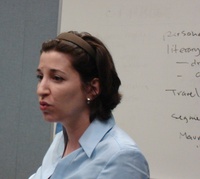Dr. Tintocalis has an MFA from the University of Iowa and a PhD from the University of Missouri – Columbia. She has published both fiction and creative nonfiction.
So what is creative nonfiction? Here, in brief, is a definition based on my understanding of her talk yesterday. Creative nonfiction begins with the writer’s experiences, but as opposed to a memoir, a diary, or a journal, seeks to find universal themes in the experience. In exploring a topic, the writer of creative nonfiction will do research of various kinds, from traditional library research to Web searches to talking with people. Creative nonfiction uses techniques such as dramatization and several points of view, but is neither fiction nor journalism.
If you are interested in enrolling in the course or simply want information about it, you may begin by contacting the department or me.


 A primary question of prospective students is, "What can I do with a degree in English?" Here is one example of sort of thing graduates of our programs do when they graduate.
A primary question of prospective students is, "What can I do with a degree in English?" Here is one example of sort of thing graduates of our programs do when they graduate.